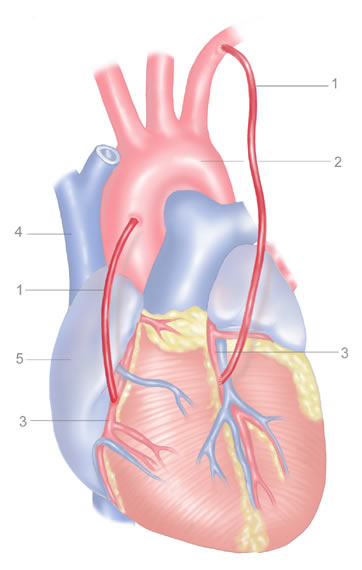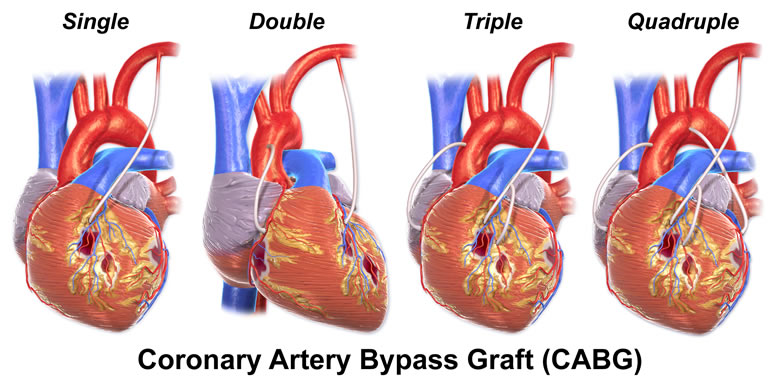Coronary Artery Bypass Graft
Coronary artery bypass graft is a common cardiac operation performed to treat a narrowed and calcified coronary artery. Atherosclerosis, the build-up of fatty deposits known as plaques, causes the artery to become narrow. This can cause the heart to become starved of oxygen, which leads to angina, and potentially a heart attack.
This is known as coronary heart disease, something which over 2 million people in the UK suffer from.
The surgery involves cutting open the breastbone, known as a median sternotomy, and grafting an artery or vein from another part of the patient's body onto the narrowed artery. This allows oxygenated blood to bypass the fatty deposits. This does not affect circulation in the areas where the donor blood vessels were removed from.

1. bypass
2. aorta
3. coronary artery
4. vena cava
5. auricle
It may involve several grafts, depending on the severity of the narrowing, and where grafts are necessary for both coronary arteries. The surgery requires general anaesthetic and takes on average between 2-3 hours. The surgeon may use a heart-lung bypass machine, or perform the surgery "off-pump" (beating heart).

Coronary bypasses are mostly required by those over the age of 50, or younger if they have contributory lifestyles. High fat diets, smoking, diabetes, and high blood pressure are risk factors for developing coronary heart disease.
Coronary heart disease is primarily associated with angina, that manifests as pain or pressure around the chest, as well as shortness of breath. These symptoms are typically brought on by strenuous exercise. Occasionally it may cause nausea, especially for women, or the pain may be localised in the neck/jaw area.
Risk factors in lifestyle, high blood pressure or cholesterol levels, and age may push a physician towards testing for coronary heart disease. Tests include: electro and echocardiogram, exercise stress test, blood test, coronary angiogram, chest X-ray, CT angiogram, and a cardiac perfusion scan.
If diagnosed early, significant improvements in lifestyle can arrest the deterioration of the coronary heart disease. For appropriate cases, stents may be inserted into the coronary arteries.
Coronary artery bypass grafts are the most common and well understood type of cardiac surgery, and are therefore generally safe and rarely result in major complications.
Success rates vary depending on the underlying complexity of each case, but 95% of patients survive the next year, and 90% the next five years. The surgical mortality rate is between 1-2%, informed by the severity of the case and other risk factors.
Recovery depends on the health and age of the individual, but a full recovery may take up to 6 weeks, with most people returning home one week after their operation. There will be a single scar on the chest area. There are limitations on heavily lifting and driving for up to six weeks after the operation.

